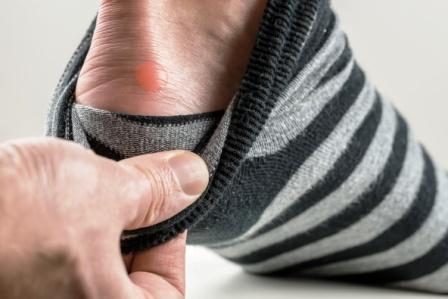Blisters: Prevention Tips, Treatment, Chances Of Cure
Article by Dr Raghuram Y.S. MD (Ay)
Blister occurs in the superficial skin layers. The blisters can be filled with serum, blood or pus.
Table of Contents
Prevention tips
Reduction of friction is the ideal way to prevent blister formation especially friction blisters.
Comfortable, well-fitting shoes and clean socks – can prevent feet blisters. On the other side, ill-fitting or stiffer shoes, such as high heels and dress shoes are risk factors for forming blisters.
Managing wet and sweaty feet – Blisters most often develop on moist skin. One has to wear socks that manage moisture. Changing the socks frequently will also be handy in avoiding the skin from getting moist. These measures will help those having sweaty feet from not developing blisters.
Special sports socks – should be used while exercising or playing sports. They will help in keeping the feet dry. This will in turn reduce the chances of forming blisters.
Shoe check – Check your shoes or hiking boots before going for a long walk or jogging
Padding – Taping a protective layer of padding or friction reducing interface (friction-management patch) between the affected area and foot wear can prevent the formation of blisters.

Bandages – Bandages, moleskin and tapes must be applied to the foot everyday (with high COF i.e. coefficient of friction).
Friction management patch – or bandages, tapes etc may be used with footwear that is worn daily. They can also be used with speciality shoes and boots like hockey skates, ice skates, inline skates, ski boots and cleats. They can also be worn with orthotic braces and splints.
Moisture wicking liner socks – These should be used with shoes in hiking and trail running; especially where water ingress or moisture build-up in the shoe or boot can occur. These socks can provide the required protection from friction.

Gloves – to avoid friction blisters on the hands, gloves should be worn while using tools like shovel or axe, during gardening or while using sports equipments like golf clubs or baseball bats or while using oars.
Taping the hands – Weightlifting and gymnastics are also associated with blister formation. Gloving or taping the hands should be done by those who are involved in these activities. Tapes are to be worn as a liner underneath a glove. The majority of these offerings add padding and create a layer that reduces coefficient of friction between the skin and the glove.
Lubricant – A lubricant, typically talcum powder can be used to reduce friction between skin and apparel. Talcum powder can be put inside the gloves or shoes for this purpose. But this might increase the friction later as it absorbs moisture. Increased frictions might lead to blisters.
Sunscreen and protective clothing – during hot summers to avoid blisters from sunburn
Avoid sunlight – during midday
Protecting gloves – while handling detergents, cleaning products, solvents and other chemicals
It is a raised portion of skin that is filled with fluid. They are often annoying, painful or uncomfortable. In most cases, they are not a symptom of anything serious. They often heal without medical intervention.
Treatment and management
Take doctors help – Some infections can cause skin blisters that require treatment. Rarely a skin condition may produce blisters. If you have unexplained blistering on your skin, you should see your doctor for a proper diagnosis and prompt treatment.
Cover your blisters – If you know the cause of blister, treat it by covering it with bandages to keep it protected.
Avoid the causes of blisters – Avoid all causes and follow the tips given in prevention of various types of blisters. Blisters caused by friction, allergens and burns are temporary reactions to stimuli. In these cases, the best treatment lies in avoiding the causes that is causing the blister. Known cause for blisters such as contact with chemicals or drugs should be discontinued.
Just leave the blisters – Many times, leaving the blister heal by itself without manipulating too much into it will work in getting rid of them
Avoid puncturing – Don’t puncture a blister unless it is very painful because the skin over the fluid protects you from infection
Treat infections – Blisters caused by infections are usually temporary. Treatment of infections will cure the blisters. Medications for infection with treatment for symptoms of blister will help.
Treat skin conditions causing blisters – Some skin conditions causing blisters such as pemphigus do not have a cure. Your doctor may prescribe treatments that will help in managing symptoms. This includes steroid creams to relieve skin rashes or antibiotics to cure skin infections.
Read related: Blisters: Causes, Differential Diagnosis, How They Manifest?
Prognosis of blisters
In most cases, blisters are not threatening conditions. Most of the blisters will get cured even without the treatment.|
prognosis depends on the quantity of blisters you have, whether they have ruptured or not or if they have become infected.
Treating the causative infections will make the blisters go away and the prognosis becomes good.
For rare and difficult skin conditions, the immunity, diagnosis and line of treatment in progress determines the nature and percentage of cure.
Click to Consult Dr Raghuram Y.S. MD (Ayu)










One comment
Aayur
it is very Use full great information thank you Dr.